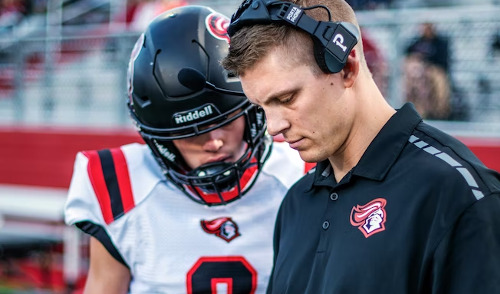We offer insights from our years of experience working with feds through the lens of football.
In my life, I have been blessed to be a part of three great, meaningful endeavors. They are, in order: my family, my career serving Feds, and playing college football. In my work every day with career Feds, I am struck by parallels between planning for a great federal retirement and what I learned from my college coaches.
With that in mind, and since we are at the end of college and pro football seasons, I thought it might be fun to share them. So here is the list and then I will expand upon each.
- A great gameplan does not need perfect players.
- Discipline in the face of adversity pays off.
- Additional investment makes a big difference.
1. A Great Game Plan Does Not Need Perfect Players.
One of the big mistakes I see in retirement planning for Feds is when someone is obsessing about products versus having a plan.
What do I mean?
Well, I really do wish I had a nickel for every time I’ve heard a Fed say, “I have all my money in ___________ fund because it’s the best.” That is the equivalent of a head coach deciding that only one player will touch the ball in the game. No single fund (or outside financial product) can be “the answer.” You need to take some time with this. You must learn and understand your tolerance for risk, then you will want to set up the correct mix of funds (a percentage in each of the 5 core funds) in your TSP and stay with that mix. You will only make adjustments to that mix to bring it back into balance. There is no academic data to support that jumping from fund to fund leads to long-term success. Know your tolerance. Set up your allocation. Stick with it and rebalance even if the market seems scary.
Which leads us into lesson 2:
2. Discipline in the Face of Adversity Pays Off.
How many times have you heard a football commentator opine: “They can’t abandon the run game,” or “They need to stay disciplined on defense.” Did you ever notice that comments like these always arise when things are not going well for the team? They never say those things after an offence has ripped off a series of big runs or a defense has had multiple three and outs. The same mindset is valuable in retirement investing.
Let’s say something farfetched was happening, like the Federal Reserve began an aggressive course of action involving large interest rate increases in an effort to tame inflation. That might have a negative impact on stock AND bond markets, right? So, what should you do?
Well, sell everything and hide in the G fund for the next few years, right?
HECK NO! (Note my college coaches did not say ‘heck.’)
However, I would like to give credit to my position coach who repeatedly told us to “Get where you are.” By this he meant do not let the noise and chaos that can happen in the game knock me off the gameplan and make me forget my training. Same rule here. Inflation, Fed raising rates, market volatility – all this can distract you from what you need to do.
Make Sure You're Fully Prepared to Retire from the Federal Government with our No-Cost Webinar Series:
You stick with your game plan.
Since you are still working, you are consistently adding money to your TSP (and outside investments). Keep it up. Remember to rebalance. Stay disciplined. Some of the greatest gains you will enjoy come from adding money when the market is down and some of the greatest losses you will suffer can come from giving in to fear and “selling out.” Set up and follow a good plan, even when you feel scared.
And remember, adding money in a down market leads into lesson three:
3. Additional Investment Makes a Big Difference.
My coaches had a common trait, they continued to teach us. They continued to invest in us.
This is a great lesson for building a federal retirement. Let me explain. I recall reading a report from TSP where they stated that 20% of TSP participants do not contribute a sufficient percentage to capture the full match. Think about that. If you are in a group of five, one of that group is not getting the full match. Is it you? If so, lets change that. If you are contributing 3%, move that up to 4 in the new year. Try baby steps, but take them every year.
Are you only contributing to the match. Great start, but we need to build that up. If you plan to retire at MRA, you will need a BIG TSP balance. Commit to “sneak away” part of your raises or COLAs until you reach the maximum percentage. Small steps!
Have you reached the point that you are contributing to the IRS maximum? Congratulations! However (you knew a but was coming, right?), this means that it is now time to consider making investments outside of TSP. By doing so in a traditional investment account, you will begin to build up assets for the future in another tax category: capital gains.
Why is this important? Within TSP, you have the ability to build up retirement assets in taxable and tax-free columns (traditional and Roth TSP, which I promise to cover in a future article) . Capital gains assets adds the third pillar. This will give you flexibility when the time comes to withdraw for retirement depending upon tax rates and rules at the time. Or, as my offensive coordinator would say, “take what the defense gives you.”
Finally, the disciplined habit of systematically adding money to your retirement portfolio leverages dollar cost averaging. My career has taught me that thrifty savings habits contribute far more to wealth building than clever or exotic investment strategies.
Start it. Add to it. Repeat!
With this article, I don’t mean to say that retirement planning is exactly like a football game. I have observed that many of the lessons apply. I hope you found this interesting and entertaining. I’ll be back soon with more thoughts and tips to help you get the retirement you deserve from your federal career.
Until then.
**Any opinions are those of the STWS writing staff and not necessarily those of Raymond James. Expressions of opinion are as of this date and are subject to change without notice. The information has been obtained from sources considered to be reliable, but we do not guarantee that the foregoing material is accurate or complete. The information contained in this material does not purport to be a complete description of the securities, markets, or developments referred to in this material. Any information is not a complete summary or statement of all available data necessary for making an investment decision and does not constitute a recommendation. Past performance may not be indicative of future results. Future investment performance cannot be guaranteed, investment yields will fluctuate with market conditions. Investing involves risk and you may incur a profit or loss regardless of strategy selected. Prior to making an investment decision, please consult with your financial advisor about your individual situation.



